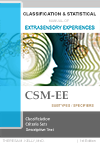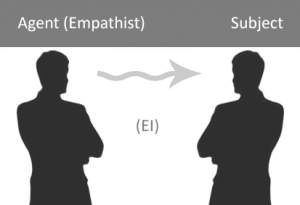 Citation: Kelly, T.M. (2014). Classification & Statistical Manual of Extrasensory Experiences. Copyright © 2014 Theresa M. Kelly, MsD. Interested professionals are welcome to Download a Complimentary Copy of the CSM-EE. This article is licensed under a Creative Commons Attribution-NonCommercial-NoDerivatives 4.0 International License.
Citation: Kelly, T.M. (2014). Classification & Statistical Manual of Extrasensory Experiences. Copyright © 2014 Theresa M. Kelly, MsD. Interested professionals are welcome to Download a Complimentary Copy of the CSM-EE. This article is licensed under a Creative Commons Attribution-NonCommercial-NoDerivatives 4.0 International License.
Phenomenological Features
The essential feature of the (EI) type of empathy is the causal influence of one mind on another’s emotional state without the intervention of the five senses. Through empathic interaction, the empathic impressionist influences the emotional state of another as a means to instruct subjects to feel a particular way that is accommodating to the empathist.


This relaxed state allows for a more dominant approach by the empathist in influencing the emotions of others, and allows subjects to be more susceptible to impression.
Hypnogenic empathy appears to not only evoke strong emotions in subjects but also typically results in prompting a behavior in subjects. Therefore, hypnotic empathic interaction appears to be the strongest form of empathy and the most dangerous, raising an assortment of moral and ethical questions as to how such an ability should be utilized in practical applications. Further studies suggest that initial empathic “impressions” (i.e. commands/evoked emotions) do not always fade away with time, but rather occasionally result in the same strength of emotion any time a subject is confronted by the empathist, or in some cases are merely reminded of the empathist (Kelly, 2012).
Intention Specifiers
The first set of specifiers is for identifying whether the experience was intentional or unintentional.
A. Spontaneous. This specifier applies when the empathist impresses the subject void of the empathist’s conscious choice, decision, or intention.
B. Intentional. This specifier applies when an empathist selects or specifies a subject to be impressed with emotional information or is coerced into action or the expression of an emotion. However, this specifier also applies when an empathist generalizes their interaction from “who” to “what” the empathist needs from the subject to result in a modification of a situation involving the subject. In the case of “what,” one or more subjects may be i-pressed.
The second set of specifiers is for identifying the subconscious or conscious need or goal that is assumed to be the catalyst for initiating empathic interactive processes.
A. Adaptive. This specifier applies when emotional information impression is initiated to assist the subject in emotionally understanding and emotionally adapting to the empathist’s needs or goals. Here the empathist typically has some level of emotional investment in the subject or the situation in which the subject occupies.
B. Directive. This specifier applies when emotional information impression is initiated to assist the subject in complying with a suggestion or command to feel a specific emotion. This is done in expectation that the subject will be provoked into acting or be-having in a specific or generalized manner as a direct result of that emotional state. Behaviors are affectional (i.e. actions which are taken due to one’s emotions, to express personal feelings). Here the empathist typically has some level of emotional investment in the subject or the situation in which the subject occupies.
The third set of specifiers is for identifying the type of impression experienced by the subject.
A. Suggestive. This specifier applies when the emotional information impressed can be identified as a proposal which may be accepted or rejected per the subject’s prerogative.
B. Compulsive. This specifier applies when the emotional information impressed can be identified as either coercive towards irrational feelings, or coercive towards rational feelings, but the subject feels they are behaving against their will or by force.
Course Specifiers
These specifiers are for identifying the characteristic course of empathic interactive experiences over time.
A. Single Episode. This specifier applies when the empathist impresses an emotion onto a subject and the empathist and subject report no prior history of episodes. This specifier also applies when the empathist suggestively or compulsively evokes an emotion in the subject, which provokes the subject into action or towards behaviors that the subject reports are not typical (i.e. the subject has not responded in such a way in similar circumstances in the past), but the empathist and subject report no prior history of episodes.
B. Episodic. This specifier applies when the empathist impresses an emotion onto a subject, which seems to occur irregularly and of which the duration of the experience is very momentary. An episodic emotional impression may involve a quick burst of emotion with the duration of the experience lasting only a maximum of a couple of seconds. This specifier also applies when the empathist suggestively or compulsively evokes an emotion in the subject, which provokes the subject into action or towards behaviors that are not typical of the subject in the past, but now the subject irregularly acts or behaves in such a manner.
C. Continuous. This specifier applies when the empathist impresses emotional impressions onto a subject of which seem to occur in a continual manner, or when episodes are so frequent it is difficult for the empathist or subject to determine where one episode ends and another begins (e.g. prolonged and closely spaced episodes).
Modality Specifiers
This specifier is for identifying the characteristic mode(s) and sub-mode(s) of an empathic experience. In any case, some emotional investment in the subject, or the situation in which the subject resides, on the empathist’s behalf is expected.
A. Dream. Refers to empathic impression during sleep where the subject is impressed with emotional information during the dream state and/or engages in an action or behavior once awake due to the impressed emotional content of the dream.
B. Intuitive Impressions/Emotional. Refers to empathic impression during normal or altered (e.g. trance) states of conscious awareness, which can be described as emotional content impressed onto a subject that may result in an action or behavior.
a. Achievement Emotions. Refers to the class of utilitarian emotions including pride (i.e. associated with an enhancement of ego-identity and self-esteem), elation (i.e. provides an individual with the feeling of living fully), joy (i.e. elicits confidence, comfort, and boosts self-esteem), and satisfaction (i.e. is contributing to a feeling of fulfillment and wellbeing).
b. Approach Emotions.Refers to the class of utilitarian emotions including relief (i.e. results subsequent to a negative emotion when an event has taken a turn for the betterment of the individual or group), hope (i.e. contains some level of uncertainty because it is future-orientated, but plays a vital role in adaptation as a means to pursue one’s goals), interest (i.e. the emotion elicited when one experiences a feeling of engagement, fascination, and curiosity), and surprise (i.e. accompanied by uncertainty, which keeps one on their toes and stimulated as a means to cope with and adjust to new and unexpected actions and events).
c. Resignation Emotions. Refers to the class of utilitarian emotions including sadness (i.e. evoked when one loses something in life such as a loved one, employment, or social standing, and is typically correlated with resignation and failure), fear (i.e. activates a sense of threat, or uncontrollability, alongside a need to preserve integrity), shame (i.e. the emotion experienced when a negative appraisal of the all-inclusive self is concerned, when an individual experiences humiliation or feels as though others find the individual insignificant or worthless, and can result in a momentary inability to think logically and efficiently), and guilt (i.e. associated with negative self-appraisal, but unlike shame, it is related to specific actions and behaviors).
d. Antagonistic Emotions. Refers to the class of utilitarian emotions including envy (i.e. the emotion evoked when an individual desires what another individual possesses and feels a sense of inferiority in comparison to the other individual), disgust (i.e. the emotion experienced when an individual is confronting something considered repulsive or abhorrent), contempt (i.e. the emotion experienced when an individual feels superior and dominant, but typically does not engage in aggressive behaviors such as assault), and anger (i.e. the emotion experienced when one feels a sense of wrongdoing, on their part or by other individuals, which is considered offensive and is accompanied by a sense of injustice, unfairness, or inequality).
e. Aesthetic Emotions. Refers to the class of emotions including those characteristic of an absence or a less pronounced function for immediate adaptation to a situation of which requires goal relevance evaluation and coping potential. In other words, the aesthetic experience of a work of art or a piece of music is not formed through the appraisal of whether the work meets physical needs, assists in furthering current goals or projects, or is in accordance with personal social values. Instead, aesthetic emotions are the product of an appreciation for the intrinsic qualities of naturalistic beauty, or the qualities of a work of art or artistic performance. A few examples of aesthetic emotions include being moved, in awe, full of wonder, admiration, bliss, ecstasy, fascination, harmony, rapture, and solemnity.
f. Compound. Several submodalities or emotions are involved, in which case each submode and identifiable emotion involved should be noted.
Associated Mental Health Findings
Mental health disorders somewhat common in experients of em-pathic interaction include: Attention Deficit/ Hyperactivity Disorder, Bipolar Disorder, Depressive Disorder, Generalized Anxiety Disorder, Obsessive Compulsive Disorder, and Panic Disorder with or without Agoraphobia, (Kelly, 2012).
Associated Medical Condition Findings
Physical medical conditions somewhat common in experients of em-pathic interaction can include: Chronic Fatigue Syndrome, Digestive Disorders, and Hypertension or Hypotension (Kelly 2012).
Differential Classification
A wide variety of extrasensory phenomena can present with similar phenomenology. These include:
- Clairvoyance and Telepathy. Applied when more than emotional content is perceived such as images, sounds, and other sensations. If the experient reports some purely empathic experiences and some experiences involving more than emotional content, the experient should be considered clairvoyant or telepathic with occasional intuitive impressions and/or hallucinations.
- Empathic Simulation. Applied when the empathic process involves the experient having a similar emotional experience at the time of an emotional information transfer with a subject (i.e. the experient is “sharing” an emotional experience of their choosing in the subject that will be accommodating to the experients needs/intentions).
Criteria for Empathic Interactive Experiences
A. Characteristic phenomenology: all of the following are required criteria for empathic interactive experiences including criteria for empathy in general.
1) Emotional information is sent by the agent and received by the subject.
2) Involves one or more individuals and direct emotional information transfer.
3) Subconscious need for emotional information impression present at the time of the experience.



